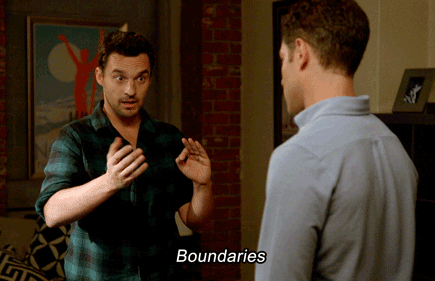Pov: you’ve just landed your dream internship, that work-study you’ve been coveting or your first ‘real’ post-grad role. You want to impress because it could be a massive boost to your career. Eagerly you take on every task, request and challenge that’s thrown your way, no matter how daunting – this is your chance for growth.
Fast-forward three months – you’re exhausted, on your 6th Starbucks of the day and staring bleary-eyed at a PowerPoint deck. Bing! Your Outlook pops up, and it’s a colleague, asking if you could proofread a doc for them before their meeting tomorrow. Arghhh! Forget making it to yoga this week – there are not enough hours in a day.
You can easily find these situations arising during college life, too – we’ve all felt the strain from juggling courses, extracurriculars and part-time work. Luckily, setting some healthy boundaries can mitigate work or school stress or burnout – both of which can negatively impact our health and productivity.
What are boundaries?
What on earth do we mean when we say boundaries? You might be aware of personal space and behavioral limits around how we engage with co-workers – most of us don’t greet our supervisors or professors with a hug. Knowing these cues can make a safe and respectful workplace for everyone. However, boundaries can also go way beyond the physical…
Boundaries are how you recognize, respect and vocalize the limits between yourself and other people.
Boundaries can be used at work, in school and in any other social situation. Sometimes colleagues delve into overly personal topics, or friends show up to a group meeting wanting to spend the first twenty minutes unloading their relationship drama and eagerly telling you what housemate did at the weekend! Your office or workspace may not be appropriate for this, and others may secretly agree. An Udemy (2019) survey found almost 4 in 10 professionals felt co-workers were too casual in workplace messages and chat.
Boundaries can also be around our time. Maintaining a healthy balance between our home, study or working lives is one of the most challenging tasks. BlueJeans (2020) estimated that many of us are adding more than 3 hours to our workday due to remote-working.
A lack of time boundaries could lead to constant responses to group emails, messages, and chats late at night or on weekends. Eventually, colleagues start turning up to meetings late (or not at all), or your superior increases your workload until you feel overwhelmed.
Why set them?
Setting your boundaries isn’t always about being defensive or reacting to people taking advantage, and it’s a way of clearly communicating fair expectations to colleagues and bosses before tough situations arise.
When done well, implementing them can make you more productive and improve your overall performance at work. They are a valuable part of self-care and maintaining a work-life balance. You may worry that this will halt or stall your progress, but boundaries can have the opposite effect – they can help you tune in better to your intentions, put time towards your actual values and goals, and improve your self-esteem. On the other hand, possible effects of poor work boundaries include insomnia, increased stress, and negative thought patterns (ruminations). (Science Daily, 2020).
It helps to know that boundaries are a two-way street. Just as you can communicate your limits, you can make sure you understand others’ expectations too! The chances are that many of your colleagues struggle to set reasonable limits on their workdays too and find themselves chained to their laptop or phone. If you agree not to check emails or respond to the group WhatsApp after 6 pm, you take that expectation off your colleagues as well. You can all get a much-needed respite from technology.
How do we create boundaries?
Okay, so claiming your boundaries (especially at work or school) is hard!
We might be fearful that people will perceive us as lazy, rude or unwilling to take on our fair share.
No one is saying that being kind, empathetic and helpful towards others is a bad thing. It’s not about neglecting responsibilities or looking to do less- instead, it’s being open so that you can take on a reasonable workload and do those responsibilities well.
A great place to start is by clarifying your intentions and understanding the other person’s expectations. With your boss or manager, this could be:
• “I’m happy to take on x, but I also need to get y in by the end of the week. Which would you like me to prioritize?”
Or
• “I would like to learn how to do x, but I’m not very confident with that yet. Could someone else on the team support me?”
With team members, this could be muting the company Slack/WhatsApp at a particular time of day or setting an out-of-office on your email to let them know when they can expect a response.
The work will still be there on Monday morning, and chances are pinging messages back and forth all weekend will not contribute much to the project- only stop you from taking a much-needed break to recharge.
Other ways to set boundaries include:
• “I’m sorry, I want to help you, but I don’t feel comfortable discussing x at work.”
• “Thank you so much for thinking of me. Unfortunately, I don’t have time to commit to that right now but would like to be considered in the future”
• “I really need to focus right now – could we find another time to talk about x?”
It’s tricky but starting small with school friends or closer colleagues can help us build up to those more significant and daunting conversations. Remember to be clear and ask yourself if this task truly brings the company or you closer to your goals and think about whether it’s outside of what someone in your position can reasonably take on.
Most of all: you are only human! It is okay to say no, and it may make you a better employee, friend and colleague in the long term.
Sources:
https://research.udemy.com/research_report/udemy-in-depth-2019-workplace-boundaries-report/
https://www.sciencedaily.com/releases/2020/06/200625122734.htm


